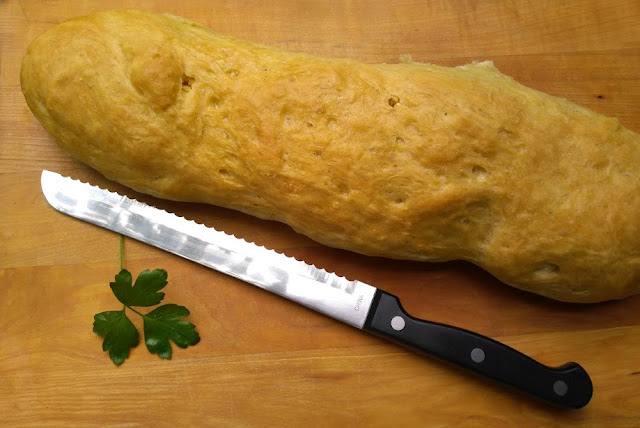Easy Portuguese Saloio Bread
(updated February 2019)
Up until Summer [finally] arrived in late June, I was making around 2-4 loaves of bread almost every Sunday since January! Then it got hot and my husband banned me from using the oven in an effort to keep the kitchen and dining room as cool as possible and not overwork our little window air conditioner.
Occasionally he would move my toaster oven out on the back deck for me to use, but I find the heating elements are too close to the bread and they over-brown, even at a lower temperature.
But the weather has cooled just a little this week and tomatoes are in season which calls for Welsh Rarebit and Bruschetta served on fresh, crusty bread. Sure, I can (and have) bought a fresh loaf at the supermarket, but there is something to be said for the smell of baking bread and I always have on hand the five simple ingredients that make it!
So, here's my attempt at something resembling a Portuguese Saloio Bread - one of our favorites for the above-mentioned summer delights. Crusty on the outside, soft and spongy on the inside. This bread is also fantastic for dipping in olive oil, balsamic vinegar, and herbs.
Easy Portuguese Saloio Bread
makes 2 loaves6 cups of flour (can sub in 1-2 cups whole wheat)
1 teaspoon of granulated salt (I prefer pure, non-iodized salt)
1 teaspoon of sugar
2 1/4 teaspoons of active/rapid dry yeast (1 sachet)
2 1/4 cups of warm (up to 100°F) water
1 tablespoon of olive oil
Variations:
Fruit Bread/Buns: add 1 cup raisins/currants/craisins (or mix) + 2 tablespoons of orange zest + 2 tablespoons of sugar + 2 tsp cinnamon + dash cardamom + dash ground cloves. Add these during first kneading.
Cheese bread: add 1 cup grated extra sharp cheddar or Asiago + 1 teaspoon garlic powder. Add these during last minute of first kneading. After shaping - brush loaf with water and sprinkle extra 1/2 cup grated cheese on top before second rise.
Instructions:
Put all dry ingredients together in a large mixer bowl and mix with a dough hook on low for 30 seconds to distribute everything evenly.
Add water & olive oil and mix for 5 minutes until the dough just comes together - it maybe a bit shaggy - that's okay!
Cover bowl (at least twice the volume of the dough ball) with a tea towel and let dough rest/rise for 1-1/2 to 2 hrs until doubled in volume. 2 hrs is better.
After rest, knead dough in mixer (or by hand) for 2-3 minutes to 'punch down'. Flour the kneading surface if kneading by hand. Divide dough into two equal portions and shape each into rounds, rustic loaves, or sticks and place on a parchment/baking mat-lined baking tray, or in two greased loaf pans. Alternatively, divide each half of the dough into eight equal portions and shape into buns. Cover with a tea towel and let rise for 45 minutes - 1hr. (again, 1 hr is best.)
At around 45 mins, heat oven to 350°F. When heated, place on the middle shelf of the oven. Bake for 30-35 minutes. Check if it is cooked through with a skewer (should come out clean) or with a probe thermometer (internal temp should be 180° or more). The crust will seem very hard/crusty when you take it out of the oven. It will soften as it cools.
Transfer to a cooling rack. Piping hot from the oven, I like to brush the top of the loaves with melted butter and then wrap them in a clean linen tea towel for a softer crust. Cool for at least 15-20 minutes before slicing.
Also great served with soup, or with butter, jam or honey! Leftovers (after a day) make great french toast (sliced 3/4" thick.)
Best eaten fresh, the day it is made. Store fully cooled in a plastic bag - 2 days out, 3-4 days in the fridge, or freeze for a couple weeks. Thaw overnight from freezer.


